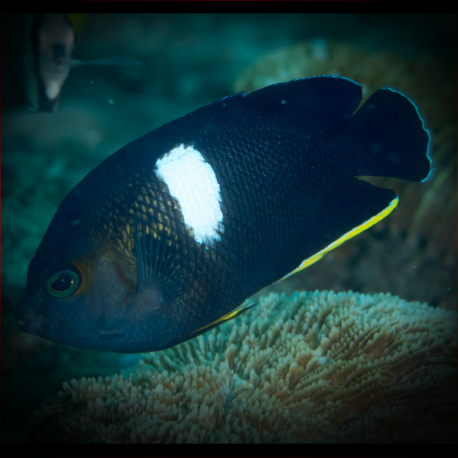More info
Datasheet
| Minimum Tank Size | 400 litres / 105.67 US gallons |
| Maximum Size | 19.0cm / 7.48inches |
| Reef Compatible | Not reef safe |
| Temperament | Mostly peaceful but might be aggressive towards similar species |
| Temperature | 22.2°C / 71.96°F - 25.6°C / 78.08°F |
| Specific Gravity | 1.020-1.025 |
| Carbonate Hardness | 8-12 |
| pH | 8.1-8.4 |
General Description
The Keyhole angelfish, belonging to the Pomacanthidae family, encompasses species like Centropyge and Paracentropyge, known for their vibrant colors and smaller size compared to other angelfish species. Typically reaching around 10 cm but occasionally up to 18 cm, they add visual appeal to aquariums. These fish, not entirely reef-safe, primarily feed on microalgae and detritus, with some species also consuming green hair algae and coral mucus, posing a risk to certain LPS, Zoanthus, and clams due to their feeding habits.
Aquarium Suitability
Considered suitable for aquariums with caution, the Keyhole angelfish require a well-established tank with ample hiding spots, especially when newly introduced. They are initially shy but can acclimate to tank mates over time. It's advisable to offer a varied diet to meet their nutritional needs, including Spirulina, nori, and fresh vegetables, to ensure optimal health.
Demands, Care, and Hardiness
With an average hardiness level, these angelfish thrive in aquariums with stable water conditions, including a pH ranging from 8.1 to 8.4, a specific gravity between 1.020 and 1.025, and a temperature of 22.2-25.6°C. Their hermaphroditic nature allows them to change gender from female to male as needed. When caring for Keyhole angelfish, it's crucial to provide a varied diet and ensure they have sufficient algae to graze on in the tank.
Reef Suitability
Not considered reef-safe, the Keyhole angelfish may not be compatible with most corals due to their tendency to nip at coral mucus. However, with careful selection and monitoring, certain species of coral like Hammer corals, Bubble corals, and Star polyps can coexist with them in a mixed coral aquarium.
Aquarium Setup
For a successful aquarium setup with Keyhole angelfish, provide hiding places, ensure a varied diet, and maintain optimal water quality. Introducing less aggressive tank mates first, choosing species with size and pattern differences, and allowing sufficient space and hiding spots can increase the chances of a harmonious tank environment.
Behaviour
These angelfish are mostly peaceful but may display aggression towards similar species. They tend to graze on algae-rich surfaces and may require supplemental feeding if natural algae levels are low in the tank.
Feeding and Diet
Keyhole angelfish thrive on a diverse diet comprising macroalgae (e.g., seaweed/nori), microalgae (e.g., spirulina), and small crustaceans like krill and mysis. Regular feeding and ensuring algae availability in the tank are vital for their well-being.
Dimorphism
The Keyhole angelfish can exhibit dimorphic traits, with females having the ability to transition to males when necessary. This natural gender change mechanism aids in maintaining a proper gender balance within their social structure.
Habitat and Distribution
Native to the Western Pacific region from Christmas Island to Fiji and ranging from southern Japan to Scott Reef and Lord Howe Island, the Keyhole angelfish prefer coral reef habitats rich in microalgae and detritus. They are commonly found in areas with ample hiding spots and algae for grazing.

